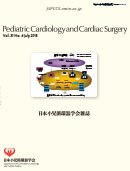Volume 31, Issue 4
Displaying 1-12 of 12 articles from this issue
- |<
- <
- 1
- >
- >|
Editorial
-
Subject area: Editorial
2015Volume 31Issue 4 Pages 135-137
Published: July 01, 2015
Released on J-STAGE: September 10, 2015
Download PDF (201K)
Reviews
-
Subject area: Review
2015Volume 31Issue 4 Pages 138-147
Published: July 01, 2015
Released on J-STAGE: September 10, 2015
Download PDF (395K) -
Subject area: Review
2015Volume 31Issue 4 Pages 148-156
Published: July 01, 2015
Released on J-STAGE: September 10, 2015
Download PDF (485K) -
Subject area: Review
2015Volume 31Issue 4 Pages 157-183
Published: July 01, 2015
Released on J-STAGE: September 10, 2015
Download PDF (1726K)
Originals
-
Subject area: Original
2015Volume 31Issue 4 Pages 184-189
Published: July 01, 2015
Released on J-STAGE: September 10, 2015
Download PDF (457K) -
Subject area: Original
2015Volume 31Issue 4 Pages 192-198
Published: July 01, 2015
Released on J-STAGE: September 10, 2015
Download PDF (509K)
Case Reports
-
Subject area: Case Report
2015Volume 31Issue 4 Pages 199-204
Published: July 01, 2015
Released on J-STAGE: September 10, 2015
Download PDF (3828K) -
Subject area: Case Report
2015Volume 31Issue 4 Pages 205-211
Published: July 01, 2015
Released on J-STAGE: September 10, 2015
Download PDF (330K) -
Subject area: Case Report
2015Volume 31Issue 4 Pages 212-219
Published: July 01, 2015
Released on J-STAGE: September 10, 2015
Download PDF (2299K)
Editorial Comments
-
Subject area: Editorial Comment
2015Volume 31Issue 4 Pages 190-191
Published: July 01, 2015
Released on J-STAGE: September 10, 2015
Download PDF (140K) -
Subject area: Editorial Comment
2015Volume 31Issue 4 Pages 220-222
Published: July 01, 2015
Released on J-STAGE: September 10, 2015
Download PDF (192K) -
Portopulomonary Hypertension and Hepatopulmonary Syndrome with Congenital Portosystemic Venous ShuntSubject area: Editorial Comment
2015Volume 31Issue 4 Pages 223-226
Published: July 01, 2015
Released on J-STAGE: September 10, 2015
Download PDF (184K)
- |<
- <
- 1
- >
- >|
